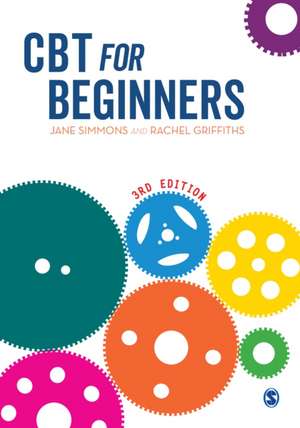CBT for Beginners
Autor Jane Simmons, Rachel Griffithsen Limba Engleză Paperback – noi 2017
Focusing on case formulation, the authors show readers how to build a 'picture' of each client, using their case history to inform interventions. Features such as exercises, case dialogues, summary boxes, and further reading lists help to enhance and cement learning.
This third edition includes updated references, further reading and exercises, and new content on:
· The difficulties and drawbacks of CBT
· The differences between formal CBT and informal CBT
· The therapeutic relationship
· Further discussion of specific formulations
· Compassionate interventions with negative thoughts.
| Toate formatele și edițiile | Preț | Express |
|---|---|---|
| Paperback (1) | 293.71 lei 22-36 zile | +26.75 lei 5-11 zile |
| SAGE Publications – noi 2017 | 293.71 lei 22-36 zile | +26.75 lei 5-11 zile |
| Hardback (1) | 1071.56 lei 43-57 zile | |
| SAGE Publications – noi 2017 | 1071.56 lei 43-57 zile |
Preț: 293.71 lei
Preț vechi: 309.16 lei
-5% Nou
Puncte Express: 441
Preț estimativ în valută:
56.20€ • 58.84$ • 46.50£
56.20€ • 58.84$ • 46.50£
Carte disponibilă
Livrare economică 17-31 martie
Livrare express 28 februarie-06 martie pentru 36.74 lei
Preluare comenzi: 021 569.72.76
Specificații
ISBN-13: 9781526424082
ISBN-10: 1526424088
Pagini: 288
Dimensiuni: 170 x 242 x 21 mm
Greutate: 0.52 kg
Ediția:Third Edition
Editura: SAGE Publications
Colecția Sage Publications Ltd
Locul publicării:London, United Kingdom
ISBN-10: 1526424088
Pagini: 288
Dimensiuni: 170 x 242 x 21 mm
Greutate: 0.52 kg
Ediția:Third Edition
Editura: SAGE Publications
Colecția Sage Publications Ltd
Locul publicării:London, United Kingdom
Recenzii
Easily accessible by students, and bringing professional therapists up to date with full and detailed practical guidance, Jane Simmons and Rachel Griffiths present both an introduction and the current state of the art application of CBT. In their third edition, the authors have achieved the very difficult aim of making a practitioner guide to the most effective evidence-based approaches a pleasure to read.
CBT for Beginners explains how to deliver CBT to young people and adults in a simple and easy to understand manner. It is an excellent resource for students, beginning psychologists and health professionals.
The latest edition of this book retains the clarity of explanation and width of content required to continue as the best introductory text to CBT available. The content is accessible and understandable to the novice practitioner and the use of case examples clearly articulate how theory is applied in practice. This edition updates information on relevant legislation and treatment advances, and is a must for any student commencing a CBT related programme.
CBT for Beginners explains how to deliver CBT to young people and adults in a simple and easy to understand manner. It is an excellent resource for students, beginning psychologists and health professionals.
The latest edition of this book retains the clarity of explanation and width of content required to continue as the best introductory text to CBT available. The content is accessible and understandable to the novice practitioner and the use of case examples clearly articulate how theory is applied in practice. This edition updates information on relevant legislation and treatment advances, and is a must for any student commencing a CBT related programme.
Cuprins
PART ONE: CBT – WHAT IS IT?
1.What is CBT?
2. Who Benefits from CBT?
3. The CBT Model
4. Levels of Cognitions (Thoughts, Beliefs and Assumptions)
5. Structure of therapy and sessions
6. The therapeutic relationship
PART TWO: CBT - HOW DO YOU DO IT?
7. CBT Assessment
8. CBT Formulation
9. Setting Therapy Goals
10. Coping Strategies
11. Behavioural Interventions
12. Cognitive Interventions: Psycho-education about Thoughts and Beliefs
13. Cognitive Interventions: Identifying Negative Automatic Thoughts (NATs)
14. Cognitive Interventions: Evaluation of Negative Automatic Thoughts or ‘Thought Challenging’
15. Cognitive Interventions: Working with Assumptions and Core Beliefs
PART THREE: AND THE REST...
16. Mindfulness
17. Problem Solving
18. Working with Emotions
19. Motivation for Change
20. Therapeutic Endings
21. Supervision
1.What is CBT?
2. Who Benefits from CBT?
3. The CBT Model
4. Levels of Cognitions (Thoughts, Beliefs and Assumptions)
5. Structure of therapy and sessions
6. The therapeutic relationship
PART TWO: CBT - HOW DO YOU DO IT?
7. CBT Assessment
8. CBT Formulation
9. Setting Therapy Goals
10. Coping Strategies
11. Behavioural Interventions
12. Cognitive Interventions: Psycho-education about Thoughts and Beliefs
13. Cognitive Interventions: Identifying Negative Automatic Thoughts (NATs)
14. Cognitive Interventions: Evaluation of Negative Automatic Thoughts or ‘Thought Challenging’
15. Cognitive Interventions: Working with Assumptions and Core Beliefs
PART THREE: AND THE REST...
16. Mindfulness
17. Problem Solving
18. Working with Emotions
19. Motivation for Change
20. Therapeutic Endings
21. Supervision
Notă biografică
Jane Simmons works as a Clinical Psychologist in adult mental health services in South Wales. She has previously worked as a project manager setting up an IAPT service in England. She has worked in the NHS since gaining her doctorate in Clinical Psychology in 2000 from the Oxford doctoral course of Clinical Psychology and also works in Independent Practice in Bristol.
Descriere
A practical and step-by-step guide to the basics of CBT updated to include new content on the difficulties and drawbacks of CBT; the differences between formal CBT and informal CBT; the therapeutic relationship; further discussion of specific formulations and compassionate interventions with negative thoughts.
